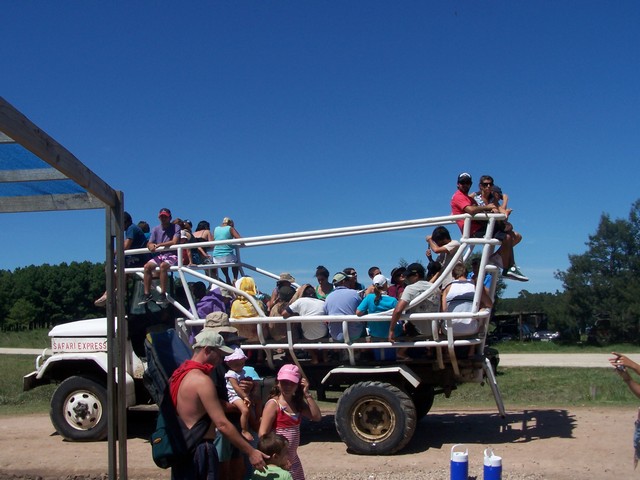article from May 4, 2011
By Jamie Douglas
Returning to Route 10, about 40 km north of La Padrera, you
reach to the staging area to get to Cabo Polonio.
To reach this wonderfully funky
outpost of Uruguayan civilization, you have to park your vehicle at the
terminal of the giant dune crawlers that will take you to the beach hamlet,
which is practically abandoned during the off-season and overrun from December
15 to the end of Easter vacation.
There is no electricity and very little water
year round, and the water tanks supplying the houses and shacks that serve
guest are filled up by delivery trucks that are allowed to come through the
dunes. The ride in and out is one of those adventures you will not easily
forget. Crammed onto the back of a monster 4-wheel drive truck that would be
equally at home in the Sahara Desert, you will be tossed back and forth along
with your fellow passengers until finally you break out of the dunes onto hard
packed sand along the beach.
As you approach, you will see a conflagration of “houses” in
various states of disrepair or near-collapse. The nation of Uruguay made this a
national park in 2009, so that all new construction is prohibited and repairs to
existing structures are discouraged by throwing as many bureaucratic hurdles in
the way as they can.
We rented a beachfront shack for a couple of days during the
season for very little money, put our feet up and watched the world go by while
sipping some of that fine Tannat wine, which is rapidly becoming a favorite
worldwide. Several restaurants serve surprisingly good food at reasonable
prices, and there are two fairly well stocked general stores that probably make
the bulk of their profits off of bottled water.
At the southern tip of the cape is a very cool lighthouse
that is just inland from a seal rookery. The lighthouse, like the one in La
Paloma, is open to the public. Electricity is run to it across the dunes, but it
is not shared with any of the private facilities there, which makes for
romantic candle- and lantern-lit dinners.
Beyond the rocky tip, the cape is lined with beaches, each
with their distinctive characters. There is a curved surfing beach on one side
that stretches out along the coastline heading south. The beach heading north
is dotted with houses built amongst the shifting dunes. Do not be surprised at
finding people in the buff on that stretch, as naturist come here to relax, and
nobody is offended by their presence.
When you have had your fill of Cabo Polonio, just go by the
“office” of the dune transporters and buy a ticket on the next available trip
out. If, upon reaching Route 10 again, you want more beaches, just keep heading
north, and you will get a chance to visit Aguas Dulces, Punta Del Diablo, Santa
Teresa National Park, La Coronilla and, at last, Barra de Chuy, where you can
join the numerous smugglers coming and going from Brazil.
Within the confines of Santa Teresa National Park, you will
find the impressive Fortaleza de Santa Teresa, a fort that was originally
started by the Portuguese but finished by the Spaniards after they captured
control of the region in 1793. In this park, you will also find Cerro Verde, a
lovely coastal bluff that enjoys even greater protection than the national park
itself. It is a nature preserve within the national park.
All of the beach towns have one thing in common: Hustle and
bustle during the season and sleepy or abandoned hamlets out of season. Prices
reflect that trend, but by looking around a bit, you can always find decent
accommodations, even in the high season.
Upon reaching Chuy, and this is not a necessity, unless you
want to buy duty-free stuff and pirated copies of popular music and movies,
there are a few very nice restaurants, and crossing into Brazil is as easy as
crossing the boulevard that separates the two countries. The median strip is
the border, but you don’t have to complete border-crossing formalities until
several kilometers into Brazil, something that you cannot do in a rented car at
the moment. You need a visa, which you have to get in Montevideo from the
Brazilian embassy. It will set US passport holders back US$140 and rising, due
to the “reciprocal fee” for the one that is being charged to all residents of
non-visa waiver countries wanting to enter the USA.
For your return trip to Montevideo, may I suggest the road
even less traveled? Follow Route 19, which heads inland to San Luis al Medio
and La Coronilla, until you get to Route 15, where you head south to Lescano,
Aigua, and the sweet little city of Minas.
From here, it is just two easy hours back to Montevideo.
I hope will enjoy this trip that you can take a week or two
to complete, when you stop to smell Uruguay in all its glory. The highways are
in very reasonable shape, and if you can’t swing a rental car, this entire
route is easily and inexpensively covered by bus, except for reaching Laguna de
Rocha.
All photos by Jamie Douglas and Julie Butler
see also: La Paloma and La Pedrera
I encourage you to write me at cruzansailor
[at] gmail [dot] com with any questions or suggestions you may
have. Disclaimer: I am not in any travel-related business. My advice is
based on my own experiences and is free of charge (Donations welcome). It is
always my pleasure to act as a beneficial counselor to those who are seekers of
the next adventure.

























No comments:
Post a Comment
Comments are moderated and do not appear immediately after posting. Thank you very much for your thoughts and input.